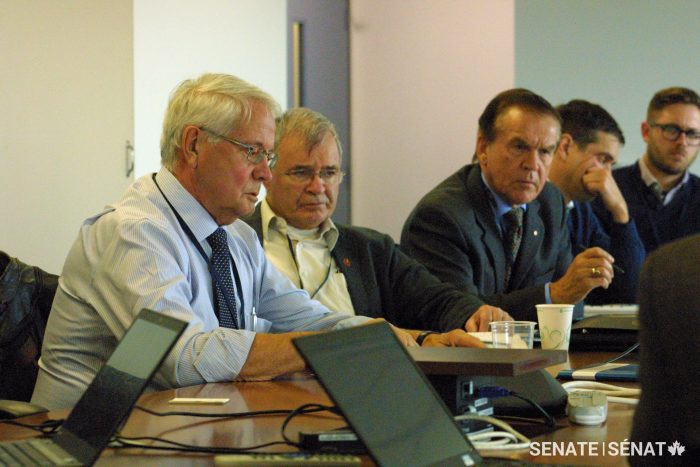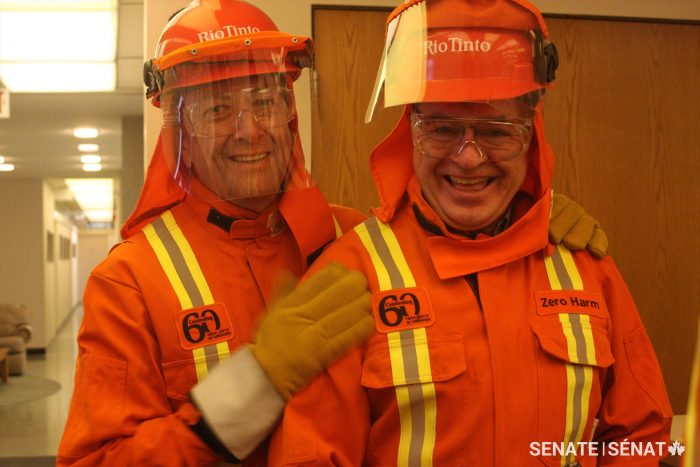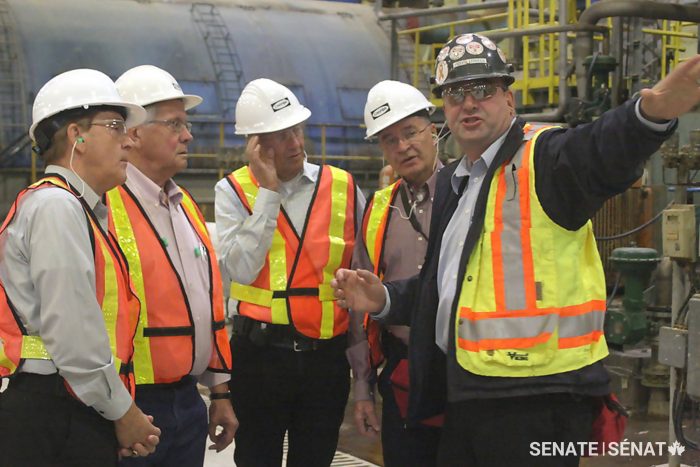Senators search for cost of GHG reduction commitments for Canadians

The Senate Committee on Energy, the Environment and Natural Resources is undertaking a new study that will examine the costs and impacts of transitioning to a lower-carbon economy. The committee will release interim reports on a sector-by-sector basis and provide a final summary report with recommendations to the federal government on how best to achieve Canada’s emission reduction commitments.
The study will focus particularly on the costs to energy users in their day-to-day lives.
To this end, the committee recently undertook a five-day fact-finding mission to three western provinces, with stops in Vancouver, Kitimat, and Prince George, BC, Calgary, AB, and Estevan, SK.
Day 1
VANCOUVER — Senators studying the importance of tackling climate change say it will come at a cost to Canadians.
“We want to find out what average taxpayers ‘Fred and Martha’ are going to pay at the end of the day,” Senator Richard Neufeld said Monday, October 3, 2016 in Vancouver where four committee members began a five-day fact-finding mission.

“No government has talked about it.”Senator Neufeld is chair of the Senate Committee on Energy, the Environment and Natural Resources, which is studying just how much it will cost for Canada to meet its greenhouse gas reduction targets.
Canada committed to reduce its greenhouse gas emissions to 30 % below 2005 levels by 2030 when the federal government signed the United Nations Framework Convention on Climate Change in Paris in December 2015.
In raw numbers, it means Canada has just 16 years to reduce greenhouse gas emissions by 291 megatonnes, Senator Neufeld said.
“If we’re going to meet that, there’s going to be a huge cost to Canadians,” Senator Neufeld said. “It’s going to change the way people live.”
Senator Neufeld was joined on the fact finding mission by committee deputy chair Senator Paul Massicotte, Senator Percy Mockler and Senator Dennis Patterson.
Senator Massicotte said the threat of climate change is so urgent Canadians don’t have a choice but to act quickly to reduce greenhouse gas emissions.
“Do we have the luxury to say you can’t get there?” Senator Massicotte said.
The committee’s findings will inform a report senators are preparing for fall 2017, which will make recommendations to the federal government about how to achieve its commitments in a way that’s sustainable, affordable, efficient and equitable.
Day 2
KITIMAT, B.C. — Canadian companies have already been investing in measures to reduce greenhouse gas, senators learned.
Mining and metals company Rio Tinto invested $4.8 billion to build a modernized smelter in Kitimat, general manager Gareth Manderson said. Building the new smelter resulted in a 50% overall reduction of emissions.
One issue senators are studying is how to protect “emission-intensive, trade-exposed” companies like Rio Tinto, as Canada works toward its greenhouse gas reduction target.

PRINCE GEORGE, B.C. — Climate change innovations could well come from smaller post-secondary institutions like the University of Northern British Columbia, senators learned.
Members of the committee visited the university’s bioenergy facility, which generates electricity and provides heat for four of its buildings on campus. The bioenergy facility burns wood chips from nearby pulp and paper mills to generate power and heat.
Professor Geoff Payne called it a “mini research and development plant.”
PRINCE GEORGE, B.C. — Canada should mobilize against climate change the way it did for the Second World War, University of Northern British Columbia sustainability manager Kyrke Gaudreau argued.
If the economy can change quickly during wartime, it can do so in the face of a new threat, said Gaudreau, one of two dozen UNBC students and faculty who took part in a panel discussion with four senators.
But there’s no “silver bullet,” committee chair Senator Richard Neufeld said — meeting Canada’s greenhouse gas reduction target will change the way Canadians live and force them to bear new financial costs.
Deputy chair Senator Paul Massicotte said Canada nevertheless needs to meet its emissions reduction target.
“We don’t have the luxury of not getting there,” Senator Massicotte said.

Day 3
PRINCE GEORGE, B.C. — New opportunities are arising for businesses as Canada reduces greenhouse gas emissions, a Prince George pulp and paper company executive told senators.
Canfor vice president Martin Pudlas told senators his company is considering using what’s called Licella technology — an Australian process — to extract biocrude oil from wood chips. The company could then sell that biocrude to oil companies to use as a fuel additive.
“This is high-risk. This is new,” Pudlas said. “Research turns money into knowledge. Innovation turns knowledge back into money.”
It’s estimated that Canfor could produce 400,000 barrels of biocrude each year using the Licella process.
Day 4
CALGARY — While some people still have questions about the cause of climate change, even if there’s just a 5% chance it is caused by human activity, something has to be done, natural gas supplier Seven Generations Energy CEO Pat Carlson said.
“The need for action on climate change is urgent,” Carlson told senators as they met representatives from the oil and gas industry, academics and an environmental group.
Carlson said he’s worried about the dire consequences associated with climate change, like the possible flooding of major coastal cities, the erosion of desert soil and the reversal of ocean currents.
Senator Richard Neufeld said meeting Canada’s greenhouse gas reduction target will have a direct cost to Canadians through carbon taxes, higher operating costs to private companies and higher electricity prices.
During one of the meetings in Calgary, the impact of climate change on the transportation sector was discussed. Climate change will also change the way Canadians live and work, Senator Neufeld said — more people might need to take public transit or work from home to reduce emissions caused by transportation.
Day 5
ESTEVAN, SK — Saskatchewan’s power authority spent $800 million to make a coal-fired electricity generator as clean as a natural gas plant and reduce its greenhouse gas emissions.
Since SaskPower opened its carbon capture and storage facility in Estevan last year, it has removed 1.2 megatonnes of carbon dioxide from emissions at the coal-burning Boundary Dam generator. One megatonne of carbon dioxide is equal to what 250,000 cars produce each year.
SaskPower relies on burning coal to produce electricity because the Prairie province’s flat geography doesn’t allow for easy generation of hydroelectricity.
Regulations requiring coal-fired generators to burn at least as clean as natural gas plants forced Saskatchewan to find a way to decrease the carbon dioxide coming out of its coal-fired electricity generators, said Mike Zeleny, project manager for SaskPower’s Boundary Dam carbon capture and storage facility.
“Without carbon capture, the coal-fired fleet, in its conventional form, will not be allowed to operate,” Zeleny said.
At the Boundary Dam generator, SaskPower removes carbon dioxide before it goes up a smokestack. The gas is pumped through a carbon capture facility — a separate plant built beside the generator — where carbon dioxide is compressed into a liquid. SaskPower then pumps pressurized carbon dioxide down a three-kilometre deep well.
READ MORE:
- Fact finding mission: Montreal
- Fact finding mission: Southern Ontario
- Read the report: Powering Canada's Territories
Related articles
Tags
Committee news
Senators search for cost of GHG reduction commitments for Canadians

The Senate Committee on Energy, the Environment and Natural Resources is undertaking a new study that will examine the costs and impacts of transitioning to a lower-carbon economy. The committee will release interim reports on a sector-by-sector basis and provide a final summary report with recommendations to the federal government on how best to achieve Canada’s emission reduction commitments.
The study will focus particularly on the costs to energy users in their day-to-day lives.
To this end, the committee recently undertook a five-day fact-finding mission to three western provinces, with stops in Vancouver, Kitimat, and Prince George, BC, Calgary, AB, and Estevan, SK.
Day 1
VANCOUVER — Senators studying the importance of tackling climate change say it will come at a cost to Canadians.
“We want to find out what average taxpayers ‘Fred and Martha’ are going to pay at the end of the day,” Senator Richard Neufeld said Monday, October 3, 2016 in Vancouver where four committee members began a five-day fact-finding mission.

“No government has talked about it.”Senator Neufeld is chair of the Senate Committee on Energy, the Environment and Natural Resources, which is studying just how much it will cost for Canada to meet its greenhouse gas reduction targets.
Canada committed to reduce its greenhouse gas emissions to 30 % below 2005 levels by 2030 when the federal government signed the United Nations Framework Convention on Climate Change in Paris in December 2015.
In raw numbers, it means Canada has just 16 years to reduce greenhouse gas emissions by 291 megatonnes, Senator Neufeld said.
“If we’re going to meet that, there’s going to be a huge cost to Canadians,” Senator Neufeld said. “It’s going to change the way people live.”
Senator Neufeld was joined on the fact finding mission by committee deputy chair Senator Paul Massicotte, Senator Percy Mockler and Senator Dennis Patterson.
Senator Massicotte said the threat of climate change is so urgent Canadians don’t have a choice but to act quickly to reduce greenhouse gas emissions.
“Do we have the luxury to say you can’t get there?” Senator Massicotte said.
The committee’s findings will inform a report senators are preparing for fall 2017, which will make recommendations to the federal government about how to achieve its commitments in a way that’s sustainable, affordable, efficient and equitable.
Day 2
KITIMAT, B.C. — Canadian companies have already been investing in measures to reduce greenhouse gas, senators learned.
Mining and metals company Rio Tinto invested $4.8 billion to build a modernized smelter in Kitimat, general manager Gareth Manderson said. Building the new smelter resulted in a 50% overall reduction of emissions.
One issue senators are studying is how to protect “emission-intensive, trade-exposed” companies like Rio Tinto, as Canada works toward its greenhouse gas reduction target.

PRINCE GEORGE, B.C. — Climate change innovations could well come from smaller post-secondary institutions like the University of Northern British Columbia, senators learned.
Members of the committee visited the university’s bioenergy facility, which generates electricity and provides heat for four of its buildings on campus. The bioenergy facility burns wood chips from nearby pulp and paper mills to generate power and heat.
Professor Geoff Payne called it a “mini research and development plant.”
PRINCE GEORGE, B.C. — Canada should mobilize against climate change the way it did for the Second World War, University of Northern British Columbia sustainability manager Kyrke Gaudreau argued.
If the economy can change quickly during wartime, it can do so in the face of a new threat, said Gaudreau, one of two dozen UNBC students and faculty who took part in a panel discussion with four senators.
But there’s no “silver bullet,” committee chair Senator Richard Neufeld said — meeting Canada’s greenhouse gas reduction target will change the way Canadians live and force them to bear new financial costs.
Deputy chair Senator Paul Massicotte said Canada nevertheless needs to meet its emissions reduction target.
“We don’t have the luxury of not getting there,” Senator Massicotte said.

Day 3
PRINCE GEORGE, B.C. — New opportunities are arising for businesses as Canada reduces greenhouse gas emissions, a Prince George pulp and paper company executive told senators.
Canfor vice president Martin Pudlas told senators his company is considering using what’s called Licella technology — an Australian process — to extract biocrude oil from wood chips. The company could then sell that biocrude to oil companies to use as a fuel additive.
“This is high-risk. This is new,” Pudlas said. “Research turns money into knowledge. Innovation turns knowledge back into money.”
It’s estimated that Canfor could produce 400,000 barrels of biocrude each year using the Licella process.
Day 4
CALGARY — While some people still have questions about the cause of climate change, even if there’s just a 5% chance it is caused by human activity, something has to be done, natural gas supplier Seven Generations Energy CEO Pat Carlson said.
“The need for action on climate change is urgent,” Carlson told senators as they met representatives from the oil and gas industry, academics and an environmental group.
Carlson said he’s worried about the dire consequences associated with climate change, like the possible flooding of major coastal cities, the erosion of desert soil and the reversal of ocean currents.
Senator Richard Neufeld said meeting Canada’s greenhouse gas reduction target will have a direct cost to Canadians through carbon taxes, higher operating costs to private companies and higher electricity prices.
During one of the meetings in Calgary, the impact of climate change on the transportation sector was discussed. Climate change will also change the way Canadians live and work, Senator Neufeld said — more people might need to take public transit or work from home to reduce emissions caused by transportation.
Day 5
ESTEVAN, SK — Saskatchewan’s power authority spent $800 million to make a coal-fired electricity generator as clean as a natural gas plant and reduce its greenhouse gas emissions.
Since SaskPower opened its carbon capture and storage facility in Estevan last year, it has removed 1.2 megatonnes of carbon dioxide from emissions at the coal-burning Boundary Dam generator. One megatonne of carbon dioxide is equal to what 250,000 cars produce each year.
SaskPower relies on burning coal to produce electricity because the Prairie province’s flat geography doesn’t allow for easy generation of hydroelectricity.
Regulations requiring coal-fired generators to burn at least as clean as natural gas plants forced Saskatchewan to find a way to decrease the carbon dioxide coming out of its coal-fired electricity generators, said Mike Zeleny, project manager for SaskPower’s Boundary Dam carbon capture and storage facility.
“Without carbon capture, the coal-fired fleet, in its conventional form, will not be allowed to operate,” Zeleny said.
At the Boundary Dam generator, SaskPower removes carbon dioxide before it goes up a smokestack. The gas is pumped through a carbon capture facility — a separate plant built beside the generator — where carbon dioxide is compressed into a liquid. SaskPower then pumps pressurized carbon dioxide down a three-kilometre deep well.
READ MORE:
- Fact finding mission: Montreal
- Fact finding mission: Southern Ontario
- Read the report: Powering Canada's Territories


